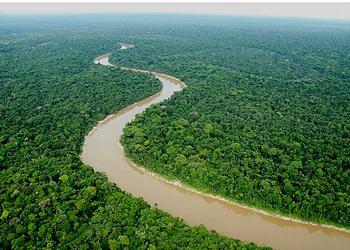
LIMA, Peru, February 22, 2018 (ENS) – Peru and Ecuador each marked the start of the year 2018 by creating national parks to protect undeveloped parts of the Amazon rainforest as yet unspoiled by illegal logging and mining.
Peru’s Yaguas National Park, created in January by the Peruvian government, sets aside 3,355 square miles (8,689 square km) of Loreto, a large region of sparsely populated Amazon rainforest in northeast Peru.

The new park contains a vast river system with one of the richest arrays of fish species in the world.
Threatened wildlife such as giant otters, woolly monkeys, Amazonian river dolphins and manatees inhabit the newly protected area.
The resident indigenous peoples include tribes still uncontacted by nonindigenous cultural groups. Those in contact with Western cultures say Yaguas National Park conserves Peru’s biodiversity and protects their ancestral lands.
“The benefits are for everyone, for the future of everyone, for the country and for the world,” said Liz Chicaje Churay, president of the Federation of the Native Communities of Ampiyacu.
Over the past 20 years, this area has faced increasing pressures from illegal logging and mining interests. During the categorization process, many indigenous communities expressed their concern over these threats and pledged their support for the national park.
“The mountain of our ancestors has to be a national park because it is a sacred place,” declared Eriberto Jiménez Hilorio, president of the Indigenous Federation of the Border Communities of Putumayo.
The Andes Amazon Fund, AAF, based in Washington, DC, has pledged to donate US$1 million towards implementing the park and providing social development opportunities for nearby indigenous communities.

The AAF supported the work of three organizations in the alliance known as Vamos Yaguas Parque Nacional that were instrumental in establishing Yaguas National Park: Instituto del Bien Común, Sociedad Peruana de Derecho Ambiental and the Conservation Strategy Fund.
These groups worked alongside the Peruvian Ministry of Environment, the Ministry of Culture, the Peruvian Protected Area Service and the many communities in favor of the park and in coordination with the Gordon and Betty Moore Foundation, the Field Museum of Chicago, and the Frankfurt Zoological Society, among others.
Pioneering scientific work by the Field Museum and Peruvian scientific counterparts has shown that the diverse Yaguas watershed has a large number of unique aquatic environments that contain some 550 species, more types of freshwater fish than anywhere else in Peru.
Communities that live downstream depend on these fish as a source of protein, as 77 percent of the rural population in Loreto eats fish daily.
Andes Amazon Fund Program Director Enrique Ortiz said, “As a Peruvian conservationist, I am proud that with the creation of Yaguas National Park, Peru continues on the path of creating one of the most amazing park systems in the world. This park is as large as Yellowstone National Park and probably 10 times as diverse.”
Conservationist Dr. Adrian Forsyth, executive director of the Andes Amazon Fund, said, “A national park of this size and significance can only be created with a long-term, multi-faceted collaboration between civil society organizations, local peoples and government agencies each fulfilling a key role.”
Mapping specialist Dr. Matt Finer, based in Washington, DC, directs the MAAP (maaproject.org) project of the Amazon Conservation and Conservación Amazónica, mapping areas of deforestation across the Andean Amazon.
Commenting on Peru’s new park, Dr. Finer said, “Yaguas now protects a huge stretch of primary Amazon forest with virtually no signs of deforestation. These kinds of big intact areas are increasingly rare, so it’s important to protect them now. There are reports of some small-scale gold mining in the new park area, but it hasn’t encroached into the forests.”
Ecuador’s Newest Park Connects Mountains With Rainforest
Also in January, the government of Ecuador created the Río Negro–Sopladora National Park. The new park forms a link between Sangay and Podocarpus National Parks, connecting a chain of mountainous protected areas along Ecuador’s southeastern Andes to the upper Amazon rainforest.

This park protects 118 square miles (306 square kilometers) of diverse and fragile ecosystems, including montane forests, cloud forests called páramos, mountain streams and rivers.
The Río Negro–Sopladora National Park lies at altitudes ranging from 2,624 to 12,795 feet (800 and 3,900 meters), taking in many precipitation levels, types of soil, and temperatures.
A report produced by Andes Amazon Fund grantee, Naturaleza y Cultura Internacional states, “The topography and weather conditions have preserved its natural ecosystems in a remarkably pristine state, still almost entirely intact and free from human intervention.”
This has allowed native animals and plants to flourish and now the area is a stronghold for imperiled wildlife such as the spectacled bear and the mountain tapir.
Many discoveries have been made in what is now Río Negro–Sopladora National Park. Working with Ecuadorian scientists, NCI carried out a Rapid Biological Assessment that registered high levels of unique species found nowhere else on Earth and numerous species new to science.
Franklin Puente, Governor of the province of Morona Santiago, said, “We must reinforce the protection of natural resources.”
“As Amazonians we are pleased to lead these important and necessary conservation processes,” said Puente. “As part of the management of the Heritage of State Areas, through the Ministry of the Environment, these spaces are recognized as a strategy to prevent the loss of biodiversity and maintain the functions of ecosystems. “
Copyright Environment News Service (ENS) 2018. All rights reserved.
© 2018, Environment News Service. All rights reserved. Content may be quoted only with proper attribution and a direct link to the original article. Full reproduction is prohibited.
